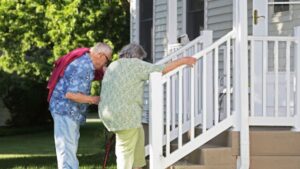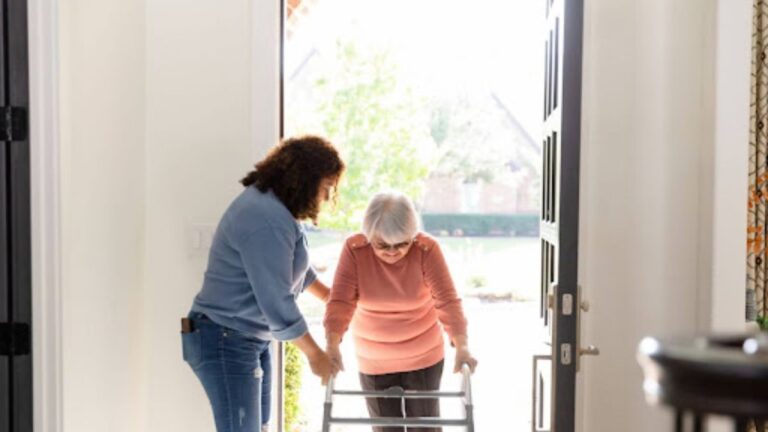Making your home safer for aging parents involves addressing common hazards like slippery floors, poor lighting, and clutter. Start by installing grab bars in bathrooms and handrails along staircases to prevent falls. Improve accessibility with non-slip mats, motion-sensor lights, and decluttered spaces. Consider assistive devices such as medical alert systems, smart home features, and mobility aids to enhance independence. Beyond physical safety, prioritize emotional well-being by encouraging social interaction and maintaining routines.
Table of Contents
- Understanding the Risks: Common Hazards at Home
- Fall Prevention: The First Step to Safety
- Accessibility Upgrades: Making Daily Life Easier
- Assistive Devices and Technology: Tools for Independence
As our loved ones grow older, their homes — once a source of comfort and familiarity — can become fraught with unseen dangers. Falls, slips, and other accidents are not just minor inconveniences; they can lead to serious injuries that compromise independence and diminish quality of life. For families hoping to keep aging parents at home, creating a safe environment is paramount.
The journey begins by understanding potential risks and implementing thoughtful modifications. By taking proactive steps, you can help your parents maintain their dignity while staying safe. Many families find that home care assistance in Winnipeg offers invaluable support in tailoring solutions to individual needs. Let’s explore how you can transform your home into a sanctuary of safety and comfort for aging parents.
Understanding the Risks: Common Hazards at Home
Before diving into solutions, it’s essential to identify common hazards that pose risks to seniors. These include:
- Slippery surfaces: Bathrooms, kitchens, and polished floors can become treacherous, especially when wet.
- Poor lighting: Dimly lit hallways, staircases, and entryways increase the likelihood of trips and falls, particularly at night.
- Cluttered spaces: Loose rugs, cords, and misplaced furniture create obstacles that are easy to overlook.
- Inaccessible layouts: Stairs, narrow doorways, and high shelves hinder mobility and make daily tasks challenging.
- Electrical hazards: Exposed wires or overloaded outlets pose fire risks and can be difficult for seniors to manage safely.
Recognizing these risks allows you to prioritize changes effectively. A thorough home assessment can reveal hidden dangers and guide your safety improvements. By addressing these hazards, you not only prevent accidents but also foster a sense of security and independence for your aging parents.
Fall Prevention: The First Step to Safety
Falls are among the leading causes of injury for seniors, often resulting in fractures, hospitalizations, or a loss of confidence. To create a fall-proof environment, consider these practical strategies:
- Install Grab Bars and Handrails
- Place grab bars in critical areas like showers, bathtubs, and near toilets to provide stability.
- Add handrails along staircases and hallways to assist with balance during movement.
- Improve Flooring Safety
- Replace slippery rugs with non-slip mats or remove them entirely to eliminate tripping hazards.
- Use anti-skid tape on tiled or wooden surfaces, particularly in high-traffic areas like kitchens and bathrooms.
- Enhance Lighting
- Install motion-sensor lights in hallways, bathrooms, and entryways to secure visibility without the need to search for switches.
- Use nightlights in bedrooms and bathrooms to guide seniors safely during nighttime trips.
- Declutter Living Spaces
- Remove unnecessary furniture, cords, and loose items from walkways to create clear, obstacle-free paths.
- Store frequently used items within arm’s reach to avoid stretching or bending, which can lead to imbalance
Accessibility Upgrades: Making Daily Life Easier
Creating an accessible home is crucial for securing your aging parents can navigate their living space with ease and confidence. These upgrades not only enhance safety but also promote independence, allowing them to perform daily tasks without unnecessary strain. Here are some impactful modifications to consider:
- Bathroom Adjustments
- Install walk-in showers with built-in seating to eliminate the need to step over high tub edges.
- Use raised toilet seats to reduce the effort required to sit down and stand up.
- Add non-slip flooring and shower chairs to further minimize risks during bathing.
- Kitchen Modifications
- Lower countertops and install pull-out shelves in cabinets to make cooking and food preparation more manageable.
- Replace heavy appliances with lightweight alternatives or position them within easy reach.
- Use adaptive tools like jar openers and ergonomic utensils to simplify meal prep.
- Entrance and Doorway Improvements
- Install ramps or threshold ramps to accommodate wheelchairs or walkers.
- Replace traditional doorknobs with lever-style handles, which are easier to operate for those with limited hand strength.
- Add automatic door openers to reduce physical strain when entering or exiting the home.
- Bedroom Enhancements
- Invest in an adjustable bed that allows for customizable positioning, promoting comfort and reducing pressure points.
- Place nightlights along the path from the bed to the bathroom to secure safe navigation at night.
- Keep emergency supplies, like a flashlight or phone, within arm’s reach of the bed.
Assistive Devices and Technology: Tools for Independence

In today’s world, technology plays a vital role in enhancing safety and convenience for aging adults. Assistive devices can bridge gaps in mobility, memory, and daily functioning, empowering seniors to maintain their independence. Here are some innovative tools and technologies worth exploring:
- Medical Alert Systems
- Wearable devices like pendants or wristbands connect to emergency services at the press of a button, securing help is available during falls or medical emergencies.
- Some systems include fall detection sensors that automatically alert caregivers if an incident occurs.
- Smart Home Features
- Voice-controlled assistants (e.g., Amazon Alexa or Google Assistant) allow seniors to control lighting, thermostats, and appliances without physical effort.
- Smart locks and doorbells provide added security while enabling family members to monitor visitors remotely.
- Mobility Aids
- Lightweight, foldable walkers or rollators offer stability and portability for outings or moving around the house.
- Stairlifts can be installed to assist with navigating multi-level homes safely.
- Medication Management Tools
- Automated pill dispensers remind users when it’s time to take medication and dispense the correct dosage, reducing the risk of missed doses or overdosing.
- Smartphone apps can track prescriptions and send reminders, helping seniors stay on top of their health routines.
Conclusion: Building a Safe and Supportive Home
Transforming your home into a haven for aging parents requires a thoughtful blend of physical modifications, emotional support, and practical solutions. By addressing common hazards like slippery floors and poor lighting, you create a foundation of safety that allows them to move freely and confidently. Accessibility upgrades, such as grab bars, ramps, and smart home features, further enhance their independence, empowering them to navigate daily life with ease.
Beyond physical safety, fostering emotional well-being is equally vital. Encouraging social interaction, maintaining routines, and providing opportunities for engagement secure that your loved ones feel valued and connected. When the demands of caregiving become overwhelming, professional services can step in to offer tailored support, alleviating stress for both seniors and their families.

